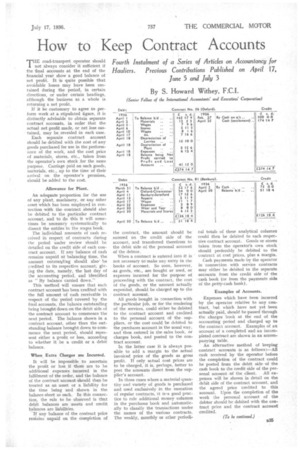How to Keep Contract Accounts
Page 45

If you've noticed an error in this article please click here to report it so we can fix it.
Fourth Instalment of .a Series of Articles on Accountancy for
Hauliers. Previous Contributions Published on April 17, June 5 and July 3 THE road-transport operator should not always consider it sufficient if the -final accounts at the end of the financial year show a good balance of net profit. It is quite possible that avoidable losses may have been sustained during the period, in certain directions, or under certain headings, although the business as a whole is returning a net profit.
If it be customary to agree to perform work at a stipulated figure, it is distinctly advisable to obtain separate contract accouiats, in order that the actual net profit made, or net loss .sustained, may be revealed in each case.
Each separate contract account should be debited with the cost of any goods purchased for use in the performance of the work, and the cost price of materials, stares, etc., taken from the operator's own stock for the same purpose. Carriage paid on such goods, materials, etc., .up to the time of their arrival on the operator's premises, should be added to the cost.
Allowance for Plant.
An adequate proportion for the use of any plant, machinery, or any other asset which has been employed in connection with the contract should also be debited to the particular contract account, and to do this it will sometimes be necessary systematically to dissect the entries in the wages book.
The individual amounts of cash received in respect of contracts during the period under review should be detailed on the credit side of each contract account. If any balance of cash remains unpaid at balancing time, the amount outstanding should also be credited to its respective account,giving the date, namely, the last day of the accounting period, and identified as "By balance carried down."
This method will ensure that each contract account has been credited with the full amount of caSh receivable in respect of the period covered by the final accounts, the belanee outstanding being brought down OR the debit side of the contract account to commence the next period. The balance shown in a contract account, other than the outstanding balance brought down to commence the next period, should represent either a profit or loss, according to whether it be a credit or a debit balance.
When Extra Charges are Incurred.
It will be impossible to ascertain the profit or Ices if there are to be additional expenses incurred in the fulfilment of the order, and the balance of the contract account should then be treated as an asset or a liability for the time being and shown in the balance-sheet as such. In this connection, the rule to be observed is that debit balances are assets and credit balances are liabilities.
If any balance of the contract price remains unpaid on the completion of the contract, the amount should be entered on the credit side of the account, and transferred therefrom to the debit side of the personal account of the debtor.
When a contract is entered into it is not necessary to make any entry in the books of account. So soon, however, as goods, etc., are bought or used, or expenses incurred for the purpose of proceeding with the contract, the cost of the goods, or the amount actually expended, should be charged np to the contract account.
All goods bought in connection with the particular job, or for the rendering of the services, could either be debited to the contract account and credited to the personal account of the suppliers, or the cost could be debited to the purchases account in the usual way, and then entered in the sales book, car charges book, and posted to the contract account.
In the latter case it is always possible to add a margin to the actual invoiced price of the goods as gross profit. If only actual cost prices are to be charged, it is, perhaps, better to post the amounts direct from the supplier's account.
In those cases where a material .quantity and variety of goods is purchased and used exclusively in the execution of regular contracts, it is.a good practice to rule additional money columns in the purchases book and automatically to rlassify the transactions under the names of the various contracts. The weekly, monthly or other periodis
cal totals of these analytical columns could then be debited to each respective contract account. Goods or stores taken from the operator's own stock should preferably be debited to the contract at cost prices, plus a margin.
Cash payments made by the operator in connection with service contracts may either be debited to the separate accounts from the credit side of the cash book (or from the payments side of the petty-cash book).
Examples of Accounts.
Expenses which have been incurred by the operator relative to any contract, but which have not yet been actually paid, should be passed through thc charges book at the end of the accounting period and charged up to the contract account. Examples of an account of a completed and an incompleted contract are shown in an accompanying table.
An alternative method of keeping contract accounts is as followsz—All cash received by the operator before the completion of the contract could he posted from the debit side of the cash book to the credit side of the per
sonal account of the client, All--expenses will be shown in detail on the
debit side of the contract account, and the agreed price credited to this account. Upon the completion of the work the personal account of the debtor should be debited with the contract price and the contract account credited.
(To be continued.)




















































































